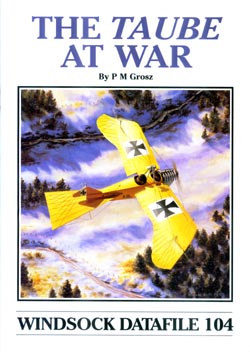 The
Taube at War The
Taube at War
Windsock Datafile 104
By P. M. Grosz
Albatros Publications, ©2004
ISBN 1-902207-59-9
Softbound, 40 Pages
The name Taube, translated as "dove," was used by many manufacturers
to describe a particular style of monoplane airframe, originally designed
by Igo Etrich. Based on observations of the seed of a tropical plant,
Taube's design was quickly imitated by a great many manufacturers in the
pre-war period, more than this book could hope to cover. Rather than limit
detail by superficially covering them all, the author chose to look at
several of the more typical Taube designers.
The companies covered with photos in this book are Albatros, Caspar,
Deutsche Flugzeug Werke (DFW), Etrich, Euler, Goedecker, Gotha, Halberstadt,
Jeannin, Kondor, Rahtjen, Roland, and Rumpler. Over this is the basic
text, which describes the development of the Taube design, outlining the
dispute between Etrich and a professor named Friedrich Ahlborn that resulted
in Etrich's design becoming public domain. Because of this there was an
explosion of Taube designs, as it was economical to produce and safe to
fly. The great stability of the type lent itself well to military service,
especially for fledgling air forces, but by the time World War One began
the Taube was outdated and a dead-end design.
In addition to the fascinating text describing the background of the
Taube, there are the usual high quality scale drawings showing the Rumpler
Taube 4C and Jeannin Taube in multiple views and two scales. Complementing
these drawings are plenty of photos of the various designs, including
some color photos of surviving examples. Rounding out the book are color
profiles on the back cover by Bob Pearson.
This is a nice little monograph on the Taube design, with a well-written
and easily followed text. The graceful design that the original Taube
influenced makes for an attractive aircraft regardless of the manufacturer,
and this book drives that fact home. If you're interested in early aviation,
this is a title well worth picking up.
|
|